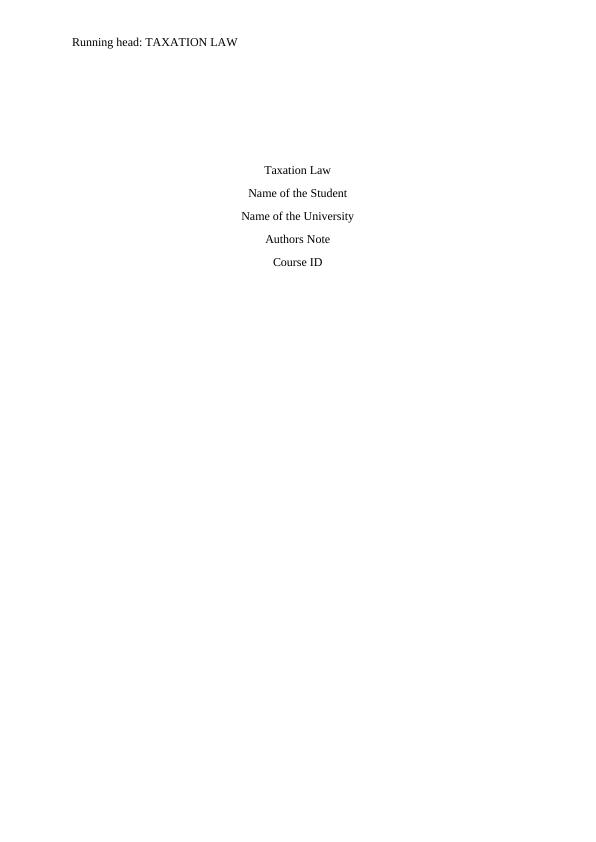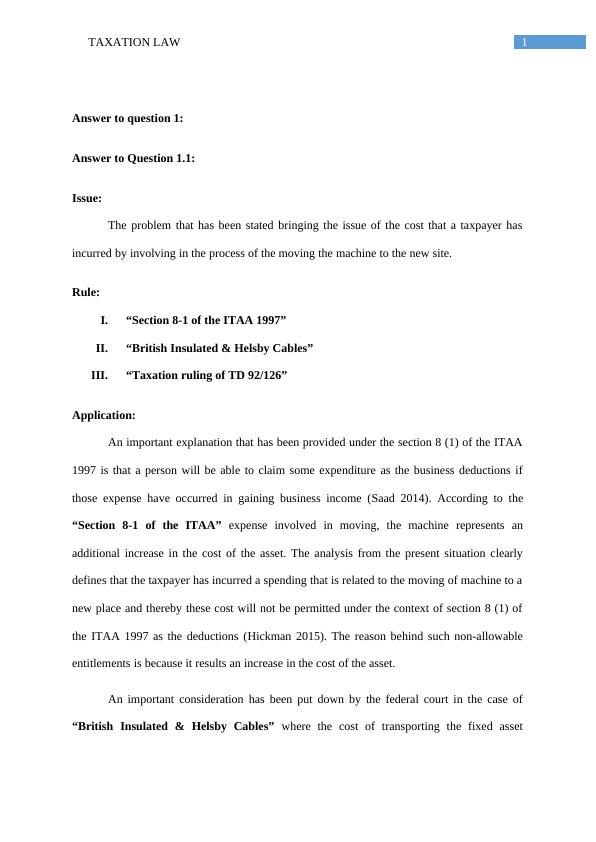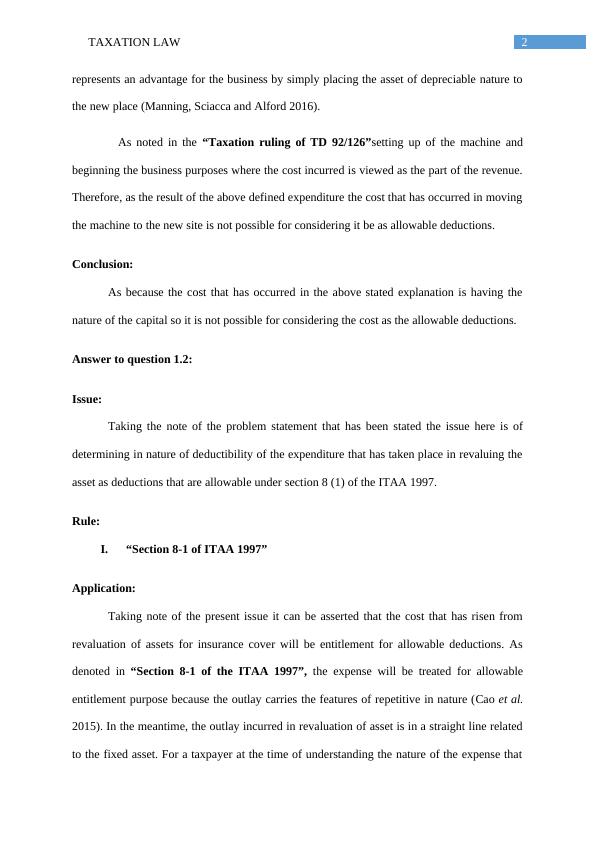Answer to Question 1.1: Taxation Law Name of the University Authors Note
Added on 2019-11-29
15 Pages3000 Words85 Views
Running head: TAXATION LAWTaxation LawName of the StudentName of the UniversityAuthors NoteCourse ID

1TAXATION LAWAnswer to question 1:Answer to Question 1.1:Issue:The problem that has been stated bringing the issue of the cost that a taxpayer hasincurred by involving in the process of the moving the machine to the new site. Rule:I.“Section 8-1 of the ITAA 1997”II.“British Insulated & Helsby Cables”III.“Taxation ruling of TD 92/126”Application:An important explanation that has been provided under the section 8 (1) of the ITAA1997 is that a person will be able to claim some expenditure as the business deductions ifthose expense have occurred in gaining business income (Saad 2014). According to the“Section 8-1 of the ITAA” expense involved in moving, the machine represents anadditional increase in the cost of the asset. The analysis from the present situation clearlydefines that the taxpayer has incurred a spending that is related to the moving of machine to anew place and thereby these cost will not be permitted under the context of section 8 (1) ofthe ITAA 1997 as the deductions (Hickman 2015). The reason behind such non-allowableentitlements is because it results an increase in the cost of the asset. An important consideration has been put down by the federal court in the case of“British Insulated & Helsby Cables” where the cost of transporting the fixed asset

2TAXATION LAWrepresents an advantage for the business by simply placing the asset of depreciable nature tothe new place (Manning, Sciacca and Alford 2016). As noted in the “Taxation ruling of TD 92/126”setting up of the machine andbeginning the business purposes where the cost incurred is viewed as the part of the revenue.Therefore, as the result of the above defined expenditure the cost that has occurred in movingthe machine to the new site is not possible for considering it be as allowable deductions. Conclusion:As because the cost that has occurred in the above stated explanation is having thenature of the capital so it is not possible for considering the cost as the allowable deductions. Answer to question 1.2:Issue:Taking the note of the problem statement that has been stated the issue here is ofdetermining in nature of deductibility of the expenditure that has taken place in revaluing theasset as deductions that are allowable under section 8 (1) of the ITAA 1997. Rule:I.“Section 8-1 of ITAA 1997”Application:Taking note of the present issue it can be asserted that the cost that has risen fromrevaluation of assets for insurance cover will be entitlement for allowable deductions. Asdenoted in “Section 8-1 of the ITAA 1997”, the expense will be treated for allowableentitlement purpose because the outlay carries the features of repetitive in nature (Cao et al.2015). In the meantime, the outlay incurred in revaluation of asset is in a straight line relatedto the fixed asset. For a taxpayer at the time of understanding the nature of the expense that

3TAXATION LAWwill be taken as deductions for income tax purpose. Henceforth, it is necessary to understandthe expenditure that has taken place for revaluing the asset is putting forward the nature of therevenue or it is merely a business expense that has occurred to protect the fixed asset. Thetaxpayer here has the spending, which is not having a permanent character of advantage tothe business, comprises of rotating business expense (Ismer 2016). So as a consequenceunder the section 8 (1) of the ITAA 1997 the cost should be considered for businessdeductions. Conclusion: The study that has been conducted above is relevant in determining the nature ofdeductions that a taxpayer will consider. So it can be evidently inferred that the cost here willbe considered for business deductions. Answer to question 1.3:Issue:The problem that has been put forward here is dealing with the spending that has beenincurred by the taxpayer with the objective of opposing the business wind up petition. Thestudy explains that whether such kind of expense can be or cannot be allowed for deductions. Rule:I.“FC of T v Snowden and Wilson Pty Ltd (1958)”II.“Section 8-1 of the ITAA 1997”Application:The problem that has been defined in the above stated issue puts forward anexplanation that winding up of business will not be considered as deductions because it is acapital cost and section (1) of the ITAA does not provides the permission of deducting such

End of preview
Want to access all the pages? Upload your documents or become a member.
Related Documents
TAXATION LAW 4 Taxation Law Name of the University Authorlg...
|13
|1825
|447
Taxation Law Assignment On Deductionslg...
|15
|2700
|49
TAXATION LAW 3 Taxation Law Name of the University Authorlg...
|13
|1611
|195
Taxation Law Assignment PDFlg...
|14
|1689
|68
Taxation Law Name of the Student Name of the University Authorslg...
|14
|2488
|60
Direct Tax Law & Practicelg...
|13
|2520
|30
